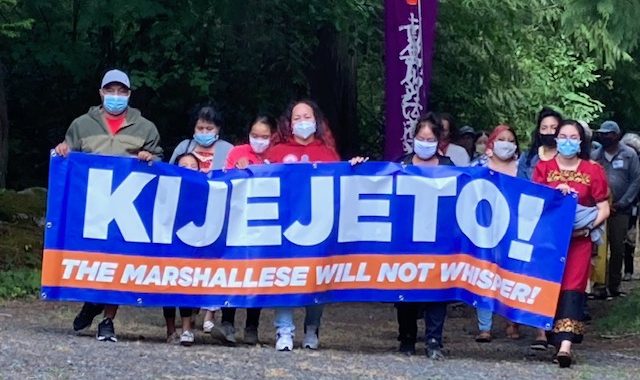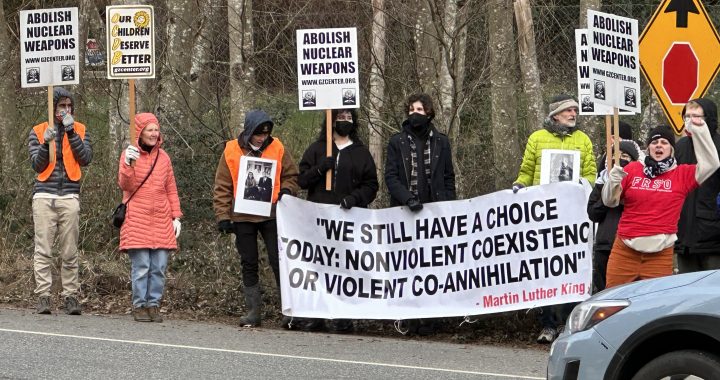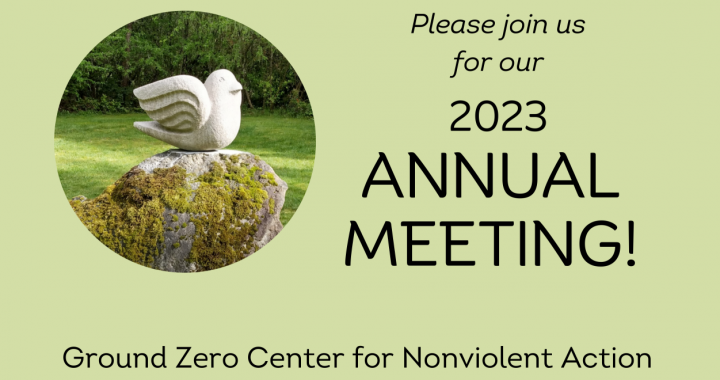Welcoming the people of the Marshall Islands – Hiroshima-Nagasaki Day Weekend
at Ground Zero Ctr. and the Pacific Northwest Peace Walk July 24- August 9, 2021
By Senji Kanaeda, Nipponzan Myohoji
Na Mu Myo Ho Ren Ge Kyo
On August 7, 2021, the day after the Hiroshima Day Lantern Ceremony in Seattle, special visitors were received at the Ground Zero Center for nonviolent action (founded in 1977).
These special visitors were 25 people from the Marshall Islands.
The United States military conducted 67 tests of nuclear and hydrogen bombs in the Marshall Islands in the South Pacific over a period of 12 years, beginning immediately after the atomic bomb was dropped in Nagasaki. The hydrogen bomb (named “Bravo”) detonated on Bikini atoll on March 1, 1954 exposed around 1,000 Japanese fishing boats including the Fifth Lucky Dragon. It is estimated that the destructive force of this bomb was 1,000 times greater than that of the Hiroshima atomic bomb.
The 25 Marshallese people marched in front carrying a banner that read: “Kijejeto”. In Marshallese, “kijejeto” means reaching the limit of their endurance. Now is the time to do their best.
And the annual Pacific Northwest peace marchers who carried a Buddhist flag followed them with chanting and drumming. All of them were welcomed to the Ground Zero center, where a peace pagoda is being built. It was a deeply emotional moment for those of us who have had a small exchange with the Marshallese during the annual peace march in Salem, Oregon’s capital.
Rachel Hoffman, who Ground Zero invited as a keynote speaker, is a 29-year-old Marshallese woman and elementary school teacher in Everett, born in Seattle. Her grandmother developed thyroid cancer after being exposed to the Bikini H-bomb and came to the United States for medical treatment, beginning a long association with the US.
The 25 visitors were members of the Marshallese Women’s Association, which was formed to revive communities that suffer from nuclear damage and poverty, and to ensure that each one of them had access to appropriate medical health, education, and work.
Their slogan, “Don’t ever whisper”, is the title of a 2013 book about the life of the first Marshallese woman to earn a master’s degree. Her name was Darlene Keju; she was one of the first Marshallese people to speak out strongly about the nuclear damage to the Marshall Islands, particularly to women and children, and to the world. Keju called her fellow citizens “champions of the atomic bomb survivors.” She died of cancer in 1996.
The first thing Rachel mentioned in her speech was a picture of a Nagasaki boy that she saw for the first time at Ground Zero on this day. The photograph of “A boy standing at the cremation site” with his sibling’s body on his back has become known to the world by a card issued by Pope Francis with the words “the fruit of war”. In that moment as Rachel spoke, the truth was shared by a single photograph, and the hearts of the Marshallese and the Japanese were instantly coupled.
“When nuclear tests were being conducted, we were regarded as animals or as people who have no words, personalities, or cultures, whose skin was dark and looks ugly; as guinea pigs, so to speak.” “In the Marshalls, they always are short of materials. Natural materials and artifacts destroyed by the nuclear tests were needed to make homes. The health of families was contaminated by radioactivity without their knowing it, and eventually they died one after another from cancer.” The average life expectancy of Marshall Islanders is 13 years shorter than that of the average American, and there is a 19-year gap compared to the world’s longest-lived Japanese.
“After the experiment, scientists came regularly from the U.S. to conduct a program to examine our health, and there was no concept of treatment or compensation in it.” Rachel spoke with a calm tone of voice, but the content of what she said was painful and intense. Secret documents and records from the U.S. nuclear test era deliberately concealed the gruesome true story behind the conduct of the test.
Rachel was followed by Lorris Edimon, a high school student who talked of water shortages caused by climate change and the crisis of submerging coral islands to express her concerns about the longevity of the islands and culture. Afterwards, Brenda Kelek, a Marshallese Community Health Navigator, who was born and raised on Ebeye Island, which has been called the “slum of the Pacific Ocean”, and who worked at the U.S. military base on Kwajalein talked about the significant pay gap between Marshallese and U.S. citizens and her experiences of harsh racism. Dr. Robin Narruhn, the Vice President of the Women’s Association, who teaches nursing at Seattle University, says the Marshallese are very short-lived. She emphasized that poverty, forced ignorance and silence of the Marshallese were all related to imperialism, colonialism and the nuclear tests. She said it is a set.
Neither woman advocated hate of a particular person or group under any circumstances, and they did not forget their gratitude for the Ground Zero Center, which provided this opportunity to speak.
Caroline, a Ground Zero member and white woman who participated in a six-day peace march and walked through Seattle with her 14-year-old granddaughter the day before, asked Rachel the last question: “How can we American white people build a favorable solidarity relationship with you and be useful?”
This was Rachel’s answer: “Since the 1980s, we have been immigrants (driven from radioactively contaminated islands) and newcomers who do not know right from left, and this includes the Marshallese Women’s Association. We need guidance from experienced people to directly reach out to politicians (lobbying); to gain access to children’s education and health care; and to earn a stable income. Above all, I think it’s a step forward that we got the opportunity to speak here, and I would like to express my heartfelt gratitude.” (*Caroline studied at a University in Tokyo for a year in the1960s and speaks Japanese.)
On the morning of July 25, when we (peace marchers) started walking in Salem, the capital of Oregon, we met Antonio Eliu, who was a Senator from Ujae atoll in the Parliament of the Republic of the Marshall Islands and also a member of the Cabinet. The graveyard at Chemawa Indian School was the starting point. In 2016, the unburied bodies of 220 Indian students were located in the graveyard by Native anthropologist Marsha Small; she thinks that probably there were many more that she was not able to find. Indian children were forcibly placed in boarding schools, where they were forbidden to speak their language or practice their culture. Many died anonymously, other suffered years of physical and sexual abuse. The march ended at an African American church on the outskirts of town, and we were warmly greeted by Pastor Marilyn Williams. Mark Babson, a long-time buddy who worked as the organizer at that evening’s gathering of five races and ethnicities, is white, lived in six countries outside the US, and speaks four languages fluently. Seven years ago, our relationship with the Marshallese began with a question from that Quaker. “There are 3,000 Marshallese people in Salem who are suffering so much from the aftereffects of the nuclear tests. Would you like to meet some of them?”
The Marshallese suggest that there is a structure of deeply rooted imperialism and racism that underlie nuclear weapons, and that these will continue to exist until these deeper roots are removed or healed. Most of the nuclear victims are non-whites (people of color) who are not native speakers of the European languages that conquered the world, such as English and French, and until recently their suffering has often been overlooked and ignored. Britain defiled the Aboriginal lands of Australia, and France also defiled people and lands in Algeria and Polynesia.
On the morning of August 9, after all the events, a Gujarati person, who teaches at the University of California San Diego, visited Ground Zero and the temple with his wife and daughter. Mr. Mohan Turivedi’s father is said to be a distant relative of Gandhi; later I learned that his father had received a letter from the Mahatma. Mohan was from Warda, where our teacher Fujii Guruji met with Mahatma, and I guided his family to the Japanese American detention memorial and our temple in Bainbridge Island after showing them pagoda under construction.
The family’s visit once again made me think about the reason for the existence of the Ground Zero Center. It is an American grassroots organization that develops Gandhi’s ideas and actions of non-violence and civil disobedience right next to the world’s largest nuclear arsenal. Of course, the family’s homeland, India, is the country of Buddha, who preaches peace and the Buddha’s relics are going to be enshrined here soon. This summer, many events were reduced and canceled, however, resulting in a landmark visit by the people of the Marshall Islands during the COVID-19 pandemic. Gassho(palms together)
*The Republic of the Marshall Islands (RMI) is a country with a population of about 80,000, mostly in eastern Micronesia in the South Pacific. Before W.W.II, it was under Japanese rule and after the war American rule. Major diplomatic relations are with the United States, which holds the national defense right. The American military base and missile center on Kwajalein atoll operates in exchange for allowing Marshallese citizens to live and work in the US, according to the 1986 Compact of Free Association (COFA) treaty. The RMI became independent in 1979.




